Airport Rail Loop Gets Thumbs Up
A conventional rail loop connection from the airport through the northern corridor and southern corridor connecting to the existing passenger rail network at Puhinui and Onehunga gets a big tick in stage one of the study investigating future transport to Auckland Airport.
This is the first phase of the so-called SouthWestern Airport Multi-Modal Corridor Project, being conducted by GHD under the co-management of Auckland Transport and NZTA. The purpose of the project is to identify the preferred route(s) and configuration of multi-modal transport connections to and from the airport and agree the best manner in which such routes can be protected.
The rationale for the rail loop was stated to be that it
- Connects with existing rail network
- Connects with key growth areas and development potential
- Forecast demand would justify a 15 min frequency in 2041
- Would have the highest benefits and offer the best network resilience
- Would provide opportunities to develop rail freight consolidation facilities in the airport corridor
Of all the options considered, the rail loop was on an economic assessment, considered the most effective response to the strategic issues and would produce the most benefits.
After consideration of the options, rail to the north and south both move to stage two of the project.
- Rail to the north because it could be a step towards full rail loop by extending the Onehunga line and would provide opportunities to develop rail freight consolidation facilities in the airport corridor.
- Rail to the south as it could be a viable first step as it provides access to North Island Main Trunk Line north and south; should be considered as part of a southern growth strategy; provides a direct connection to Manukau and wuld provide opportunities to develop rail freight consolidation facilities in the airport corridor.
Bus shoulders on the motorway were thought to be possible for consideration as complementary to the rail options and also as part of a transition while traffic levels build up to a level that would justify a rail option.
Light rail to the north was rejected as not providing a “single seat” connection with the established public transport network . A rail or bus connection to the east was also rejected as it would miss the development opportunities at Onehunga and to the north of the study area.
A “multi-modal” transport solution was said to be the key as roading improvements would not be enough to meet future needs.
Last year a Memorandum of Understanding was developed by Auckland Transport and NZ Transport Agency (NZTA) together with Auckland Council, KiwiRail and Auckland International Airport Ltd to undertake the this project.
On receiving the report the parties have agreed that the rail loop should be further developed in stage two “in accordance with NZTA and Treasury guidelines” but also added a “realistic alternative package” would also be considered.
This study echoed findings of previous studies that airport passenger growth is the key driver of land transport demand.
The modelling indicates that the demand for vehicle travel to the airport is expected to increase significantly over the next 30 years. In particular:
- The current capacity of SH20A as a 4-lane expressway will be exceeded around 2015 and, after upgrading to a 4-lane motorway, its capacity will be exceeded by approximately 2025
- SH20B carries less traffic and is expected to grow at a slightly lower rate; however it is currently reaching its capacity as a 2-lane expressway.
- It is assumed additional capacity will be provided on SH20A and SH20B as traffic grows. However, the Phase 1 modelling suggests congestion on SH20 and the wider network has the potential to negate any potential road capacity improvements beyond improving a four-lane SH20A to motorway standard.
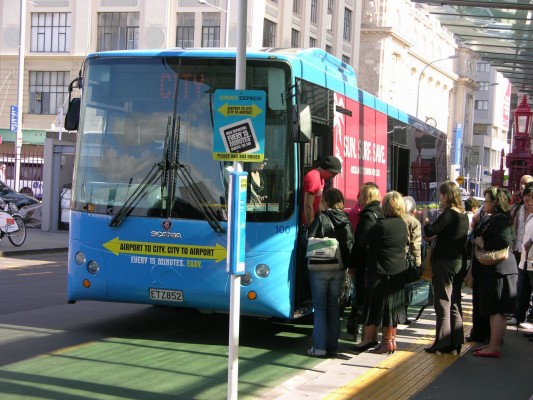 The modelling indicates that approximately 30-50 buses per hour would be required to service the peak demand at the airport, equivalent to between a 1 minute and 2 minute frequency by 2026. At these levels, internationally accepted transport planning practice suggests that consideration should be given to providing rail or dedicated busway services to ensure reliability and to avoid bunching. A dedicated busway option, at this level of frequency, would require substantial investment in bus facilities at and approaching the airport for this to be an attractive, reliable option in the long term option.
The modelling indicates that approximately 30-50 buses per hour would be required to service the peak demand at the airport, equivalent to between a 1 minute and 2 minute frequency by 2026. At these levels, internationally accepted transport planning practice suggests that consideration should be given to providing rail or dedicated busway services to ensure reliability and to avoid bunching. A dedicated busway option, at this level of frequency, would require substantial investment in bus facilities at and approaching the airport for this to be an attractive, reliable option in the long term option.
Growing road congestion and increasing parking costs would make such right-of-way public transport an increasingly attractive mode of travel, particularly in peak periods, as has been the experience with the Northern Express Service.
The report says to achieve these impacts, the strategic approach would need to incorporate a multimodal package of transport improvements, comprising state highway improvements, local transport improvements and high capacity public transport services from the airport to the key origins and destinations of its users and workforce.
The timing of the various elements of the package would be triggered by the rate of growth in air passengers and freight, the rate of land use development in the study area, and the growth in transport demand generally in the surrounding transport system.
New rail services at the airport would have operationally impacts on existing passenger and rail freight system, for example the Britomart rail terminal would need the capacity to handle the additional passenger rail services.
Similarly, additional express bus services from the airport to the city would raise issues, for example whether the CBD road network and Britomart bus terminus could accommodate the additional bus movements involved.
The multi-modal options being suggested for consideration were boiled down to these seven:
- Package 1 – Rail loop. This would comprise rail links from the airport through the northern corridor and southern corridor (connecting to the existing passenger rail network at Puhinui and Onehunga), plus the common elements (state highway, arterial road and local transport improvements)
- Package 2 – Light rail to north. This would comprise dedicated light rail link from the airport through the northern corridor to Onehunga (connecting to a light rail network running into the CBD or to a rail station at Onehunga), plus the common elements (state highway, arterial road and local transport improvements)
- Package 3 – Busway to north or south. This would comprise dedicated busway from the airport through the northern and southern corridor connecting to the existing bus and rail networks through interchanges, plus state highway, arterial road, and local transport improvements.
- Package 4 –Rail connection to the south. This would comprise a rail link from the airport through the southern corridor connecting to the existing passenger rail network, plus State highway, arterial road, and local transport improvements.
- Package 5 –Rail connection to the north. This would comprise a rail link from the airport through the northern corridor connecting to the existing passenger rail network, plus State highway, arterial road, and local transport improvements.
- Package 6 – Bus lanes on the motorway shoulder. This would comprise express bus services from the Airport through the northern corridor and southern corridor using motorway hard shoulders, plus state highway, arterial road, and local transport improvements.
- Package 7 – Rail or dedicated busway through Otahuhu. This would comprise rail or busway links from the Airport through the eastern corridor, plus state highway, arterial road, and local transport improvements
Packages 1, 4, 5 and 7 were assessed highest in responding to the growth in travel demand. Packages 1 and 4 was scored highest on addressing connectivity in the local transport network. Their impacts were assessed as ‘very positive.”

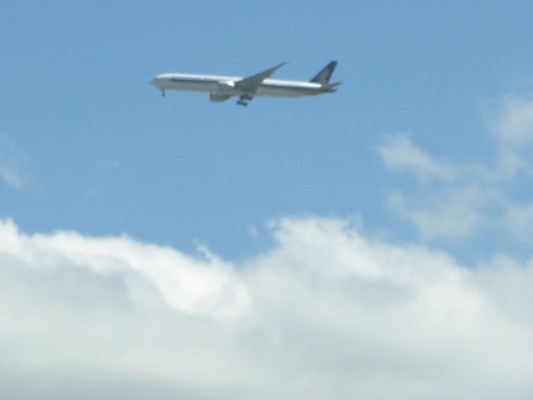
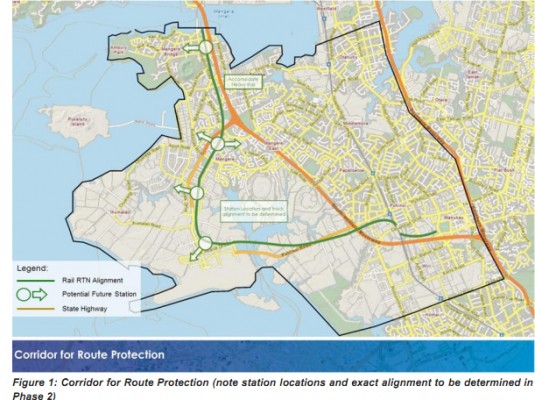
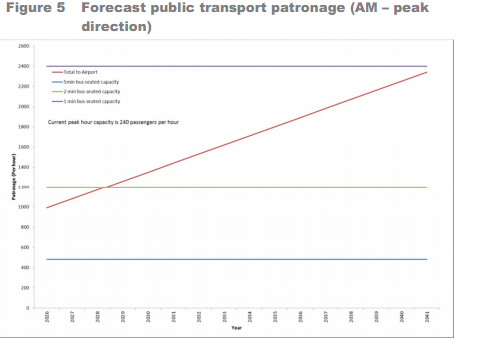
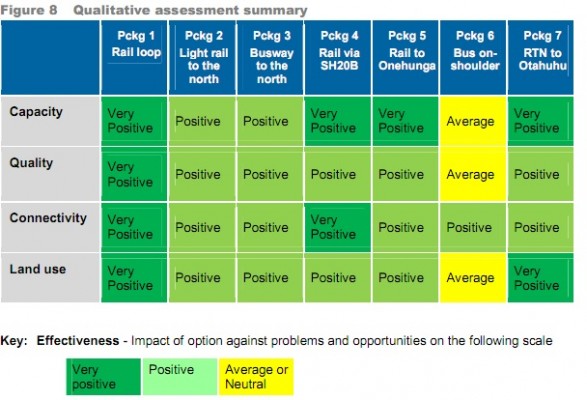
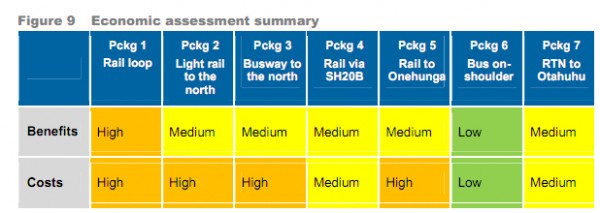

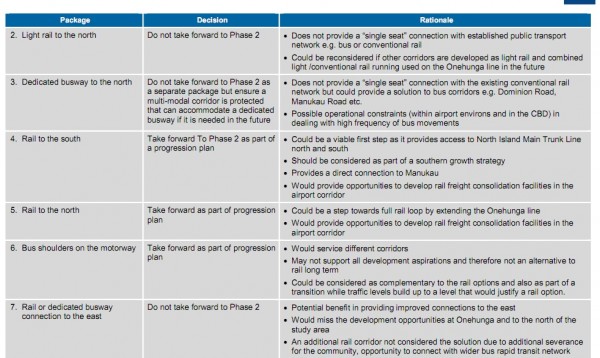










17 Comments
To me it seems that this is pretty much the same outcome as a similar study a few years ago by the ARC. Once again the alternatives to a rail line failed because they would require their own corridor into town where as the rail network only has to connect up to Onehunga and Puhinui.
The only real difference is that the NZTA are involved in this one so hopefully the government will have less basis to reject the business case when that phase is done. It would also be good for the council to highlight to the public that this can’t happen without the CRL due to capacity constraints with Britomart.
So if you accept that this needs to be in place by 2025 and the build time would be 3-5 years and the CBRL is necessary to add the capacity to Britomart. Then we really need the CBD rail link in place by 2020. Sounds like a good timeframe.
Woulod not the shortest and least expensive route be from the Airport via the Southern Line?
@JD, it’s not just about getting to the city from the airport but also all points between, that’s when we really get value from the new additions to the network. Also Mangere suffers from being terribly chopped up by the motorways and this line will not only connect the people both to the airport [for jobs as well as travel] and the city but also to Manukau. The full loop should clearly be built.
I would go further in fact: at the same time the Manukau line should be extended to Botany Town Centre to really tie the south together. Other than crossing SH1 this would not be too expensive as there is space next to Te Irirangi Drive. Botany could really become a transport hub for the south east.
Now we wait for the Stephen Joyce discrediting of the study.
Do we need report after report after report in the last few years???? Get on with the real work like future proofing the rail corridor now and do the real work very soon. Otherwise we will never get it done.
we should already have had rail to the airport years ago! Let us not sit down and wait but get on with it! The CBD rail loop should start building beginning next year, if it was me, and the airport rail as well! Airports are a gateway to our country and therefore also our economy.
No money. That is all it comes down to, folks, as long as Steven Joyce is in power. Rail travel could CURE CANCER and Joyce still wouldn’t support it more than grudgingly.
Unless Nats gets voted out, this year or in 3 years, we can only dream about airport rail, and do more studies… it will be hard enough to progress the CBD rail tunnel, any work on airport rail will be just planning and maybe a bit designation work.
” …a 15 minute frequency in 2041.” How does a model make predictions thirty years ahead with any degree of accuracy?
I think if the airport link was running now there would be periods in a day where that frequency would be needed. Thirty minutes off peak now feels about right.
Agree with patrick entirely in going for gold and getting the Manukau Line extended out to Botany. The space is there as it was set aside when Te Irirangi Drive was built. Only catch was crossing SH1 and getting through Manukau City Centre itself to the Manukau Station. (another tunnel anyone).
I suppose we could go for platinum and extend the rail from Manukau to Botany THEN extend it some more along the defunct Eastern Highway route (I wish someone would bring it back though modified) and connect it at Panmure forming a nice South Eastern Loop (yet another loop as the Auckland Transport Blog said).
That way all of Southern Auckland would be within a reasonable distance of a rail line \o/
This is what we need Ben:
http://transportblog.co.nz/2010/12/17/southeast-rtn-busway-rail-trolley-bus-or-light-rail/
Now this can be staged, Manukau to Botany first- when the airport line is in. Nick Reid who came up with route reckons SH1 can be bridged whereas I was thinking tunnel from current Manukau Station to Te Irirangi. Bridge would be cheaper I guess.
Agreed, tunnel to Manukau would to avoid going over SH1 would be more viable.
Not sure I send the link to Highland Park though - but then again never thought of it until you linked it. Might take a closer look at it now
Have a look Ben, it’s genius: means it can then link across the Tamaki to the Eastern Line at GI. Soooooo fast to the city and beyond, or the other way to Manukau City and the airport. Doesn’t matter too much where the stations are as they will only work with smart integration with feeder buses and car drop-off so everyone in Howick, Pakuranga, Sunny Hills, Bucks Beach etc can get on those fast ‘n’ frequent electric trains and get snappily to anywhere on the network.
Would become crazy popular heading both north and west as the options for getting out of SE Ak are, frankly, shit.
Would transform this isolated dormitory suburb.
Looking now (while taking a break from submission writing).
Ok you have me sold Patrick on the SE Rail Loop. )
)
Wait NOW you have definitely sold the concept to me Patrick - I was going back over my Auckland Plan submission and had noted that Manukau City should become a Secondary (or more to the point) the Second CBD of Auckland (seems Manukau is so close to the Airport, state highways 1 and 20 and soon the main rail line as well as industry). So a South Eastern Rail Loop would further unlock potential to the South East (and make that Botany-Manukau all day shopping trip that much more efficient
@Malcolm “Now we wait for the Stephen Joyce discrediting of the study.”
He’ll be an opposition MP come November. He’ll get bored, quit and some other National List candidate will take his place.
I’ve already worked out he has nothing to offer the country, next the country will realise it, and then he himself will.
Matt, well put.
[Place's CV in to become next Minister of Transport]
Wait can’t, I am not “pro-roading” enough.